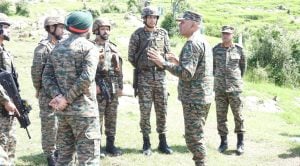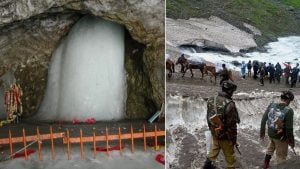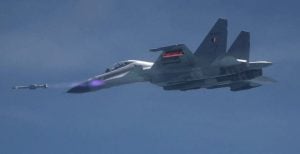China completes Beidou navigation system to bolster its own military space assets
- The satellite, the 55th in the family of BeiDou that means “Big Dipper” in Chinese, was launched at 9:43 a.m. (Beijing Time) and sent into the pre-set orbit by a Long March-3B carrier rocket from the Xichang Satellite Launch Center in southwest China’s Sichuan Province.
- The cluster of navigation satellites — part of a $10bn system called BeiDou Navigation Satellite System (BDS), — is made up of 35 satellites and provides global navigation coverage.
- The new Chinese BDS navigation system is one of four global navigation satellite systems in the world. The other three global navigation systems are GPS of the United States, Galileo of the European Union, and GLONASS of Russia.
- The Chinese global navigation system will provide critical positioning capabilities to military, civil, and commercial users around the world.
- BDS is used to aid land, sea and airborne navigation, geographical exploration, cartography and geodesy, surveying, vehicle location systems, search and rescue operations, aerial refuelling and rendezvous and a wide range of additional applications, including as a method of navigating the missile to the target.
Army chief General Naravane visits forward areas in Ladakh; awards commendation cards to soldiers who fought during face-off with China
- Army Chief General MM Naravane on Wednesday visited forward areas in eastern Ladakh and reviewed the operational situation on the ground in the wake of the border standoff with China. General Naravane arrived in Leh on a two-day visit to the region.
- He also awarded commendation cards to soldiers who fought valiantly with the People’s Liberation Army (PLA) during the recent face-off with China in the region.
- The Army chief also commended the troops for their high morale and exhorted them to continue working with zeal and enthusiasm.
- Army Chief General MM Naravane on June 23 interacted with soldiers at the Military Hospital in Leh. Prior to his visit, the Army chief held discussions with all the commanders in Delhi. After reaching Leh, General Naravane first visited the Military Hospital to meet soldiers, who were injured during the violent clashes at the Galwan Valley in the eastern Ladakh on June 15 night.
- He was then given detailed information about the position of Indian and Chinese troops on the ground, besides the meeting held between the Chinese Army on June 22.
- According to sources, Pangong Lake is now becoming the main issue, as the Indian Army has raised objections to the construction work on China’s Finger 4. Earlier on May 5, Indian and Chinese soldiers had clashed in Pangong Lake itself.
NATO exercises with Tunisian Navy in the Mediterranean
- Standing NATO Maritime Group Two (SNMG2) ships and Tunisian Navy vessels performed a passing exercise in the Western Mediterranean Sea on 22 June 2020.
- The Standing NATO Maritime Group Two, now at the end of the Italian Command, exercised with two Tunisian Navy units – offshore patrol vessel Syphax and the fast patrol boat Hamilcar. The exercise was conducted in the waters north of Bizerte, Tunisia, with the four vessels performing a communication drill, followed by a manoeuvring series, concluded by the traditional ‘sailpast’ and a salute between the four vessels.
- Tunisia, partnership with which falls under NATO’s Mediterranean Dialogue, has a long-lasting cooperation with NATO. The objectives are, for both sides, to enhance interoperability, improving maritime security and deterring potential terrorist threats at sea.
U.S., Japan holds naval exercise amid increased Chinese activities in South China Sea
- Command Destroyer Squadron 7 reported the Independence-variant littoral combat ship USS Gabrielle Giffords (LCS 10) and Japan Maritime Self-Defense Force (JMSDF) Kashima class-training vessel JS Kashima (TV-3508) and Shimayuki-class training vessel JS Shimayuki (TV-3513) jointly held a naval exercise in South China Sea.
- In the same region, were previously spotted Chinese electronic surveillance aircraft. Japan identified Chinese Shaanxi Y-9JB (GX-8) electronic warfare and surveillance plane flying along the borders.
- Some of the events included bilateral communications exercises, division tactics to practice precision maneuvering, and a photo exercise. All the events were designed to enhance interoperability between the two navies and to enable the ships to practice communicating and coordination while operating in close proximity to one another.
Russia, US hold new nuclear arms talks, but without China
- American and Russian negotiators on Tuesday concluded a round of nuclear arms control talks in Vienna, aimed at producing a new agreement to replace the New Strategic Arms Reduction Treaty (New START) that expires in February — the last remaining pact constraining the arsenals of the world’s two major nuclear powers.
- New START, signed in 2010, imposes limits on the number of US and Russian long-range nuclear warheads and launchers.
DRDO developing agricultural technologies for locals and army in high altitude areas of Eastern Ladakh
- The Defence Institute of High Altitude Research (DIHAR), a DRDO lab based in Leh, has been contributing to the agro-animal development of the Ladakh region by providing training programs on the cultivation techniques and technologies that it has developed for locals at places such as Shyok, Darbuk, Tangtse and Demchok.
- The institute has been mandated to boost the local availability of fresh food for troops deployed in the Ladakh sector by local farmers by developing technologies through research and development programmes.
- The border villages, where the DIHAR has been carrying out outreach programmes, are located close to key military locations along the Line of Actual Control with China. This ensures that what is produced by farmers at these villages can easily reach troops.
- For instance, the villages, Shyok and Darbuk, are the main areas located on a 255-km road to Daulet Beg Oldie, which is 20 km south of the strategic Karakoram pass (that divides Ladakh from China’s Xinjiang province) and the location of an advanced landing ground. The areas are also located to the site of the over month-long confrontation between Indian and Chinese troops in Galwan Valley, Hot Springs and Pangong Tso.
- Villagers from Shyok are trained on different cultivation techniques at DIHAR’s branch in the Siachen sector, located north of the village.
- Greenhouse technologies developed by DIHAR have also been set up at Shyok. They were developed, because the fresh vegetables could not be grown in the open during winters in the region when temperatures dipped to -25 degrees Celsius. The lab developed the trench greenhouse for this purpose, which can be developed by locally available resources.
- The institute has installed greenhouses for vegetable production throughout the year at remote army posts, which are not easily accessible by vehicles and therefore regular supply of fresh vegetables is affected. It has also been conducting regular training for army personnel on agro-practises for these greenhouses.
- The DIHAR has developed the polyench greenhouse technology, which has been adopted by the State Agriculture Department, Ladakh Autonomous Hill Development Council (LAHDC), that provides 50 percent subsidy to farmers for adopting the technology. It has also developed an improved passive solar greenhouse named ‘Ladakh Greenhouse’ wherein the night temperature remains 8-12°C warmer as compared to traditional passive greenhouses.
- DIHAR has also developed a net-zero energy based potato storage technology, an underground structure, to cater to the army’s requirement of fresh potato supplies during the winters in remote corners of Ladakh. Officials said that with the help of this technology the army can meet their demands of the vegetable from local farmers.
- Earlier, there was not any cost effective storage technology for potatoes that can be applied in Ladakh. Potatoes have to be air transported from Chandigarh during winters and sometimes during summers to cater to the army’s demand.
- The DIHAR has managed to grow 101 different types of vegetables at its research station. Farmers in Ladakh have adopted technologies to grow 23 types of these vegetables and supply them to the army through the farmer’s cooperative society. Local farmers, presently, are able to meet 48 percent of the army’s fresh food requirement.
- As water is a scarce resource in Ladakh, the institute has also done extensive studies on black plastic mulching (a protective covering spread on the ground to reduce evaporation and maintain even soil temperature), which has resulted in a two-fold increase in crops such as tomatoes and capsicum. Farmers in Ladakh are now extensively using this technique.
- The DIHAR has also introduced watermelon into the fields of local farmers. Last year, local farmers supplied 3.5 metric tons of the fruit to the army.
- The institute has also created a high-altitude survival garden to impart training to army and paramilitary forces about survival and emergency food for use during patrolling and mountain warfare.
Army builds bridge near Assam gas well fire site
- Indian Army personnel have constructed a bridge near the burning natural gas well in Assam’s Tinsukia, which will help in extinguishing the flames.
- The 150 metre long Bailey bridge, constructed over a water body near the gas well of Oil India Limited (OIL) at Baghjan which had a blow out on May 27 and caught fire on June 9, will help deliver water needed to control the fire and plug the blowout.
- According to Guwahati-based army spokesperson Lieutenant Colonel P Khongsai, construction of the bridge required the transportation of 233 metric tonnes of materials over a distance of 400km.
- 150 specially trained troops undertook the task under extremely risky and hazardous conditions in the vicinity of the raging fire with working temperatures exceeding 75 degree Celsius. Undaunted by the multitude of engineering challenges Army constructed the bridge in a short time of 24 hours on June 22 under heavy rainfall and extreme temperatures.
- According to OIL, the pipeline over the bridge will carry water from the nearby Dangori River to the well.
Kazakhstan receives new batch of Mi-35M attack helicopters
- Four new Russian-made multifunctional attack helicopters Mi-35M have arrived at an airbase in western Kazakhstan as part of the country’s rearmament program with Russia.
- The pilots and engineering crew underwent theoretical and practical retraining for these types of helicopters. The multirole Mi-35M attack helicopter is a comprehensive modernisation of the Mi-24V.
- The Mi-35M is distinguished by its improved construction. It is equipped with the latest Klimov-produced powerful VK-2500 turboshaft engines, fibreglass main rotor blades, main rotor head with elastomeric joints, a new swashplate and X-type tail rotor. The Mi-35M’s fuselage boasts shortened stub wings and fixed landing gear.
REVIEW QUESTIONS
- Newly launched Chinese navigation system:
- Beidou
- Xichang
- Galileo
- None of the above
ANSWER: A
- Beidou Navigation System is made up of how many satellites?
- 32
- 35
- 72
- 14
ANSWER: B
- Which Navy vessels and NATO ships performed a passing exercise in the Western Mediterranean Sea on 22 June 2020?
- Tunisian Navy
- Italian Navy
- French Navy
- Egyptian Navy
ANSWER: A
- DIHAR full form:
- Defence Institute of Integrated Analytic Research
- Defence Institute of Heterogenous Analysis Research
- Defence Institute of High Altitude Research
- Defence Institute of High Analysis Research
ANSWER: C





















